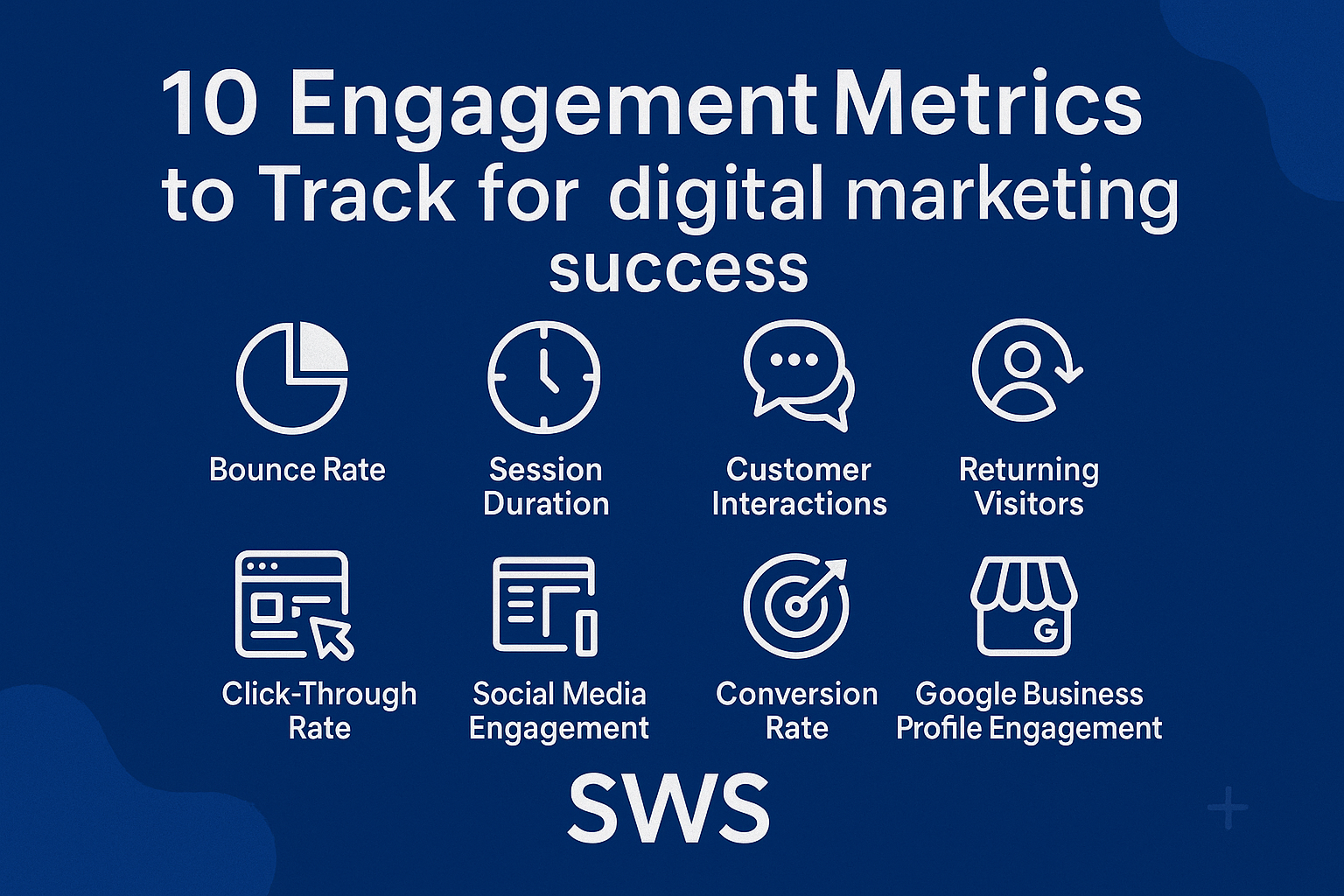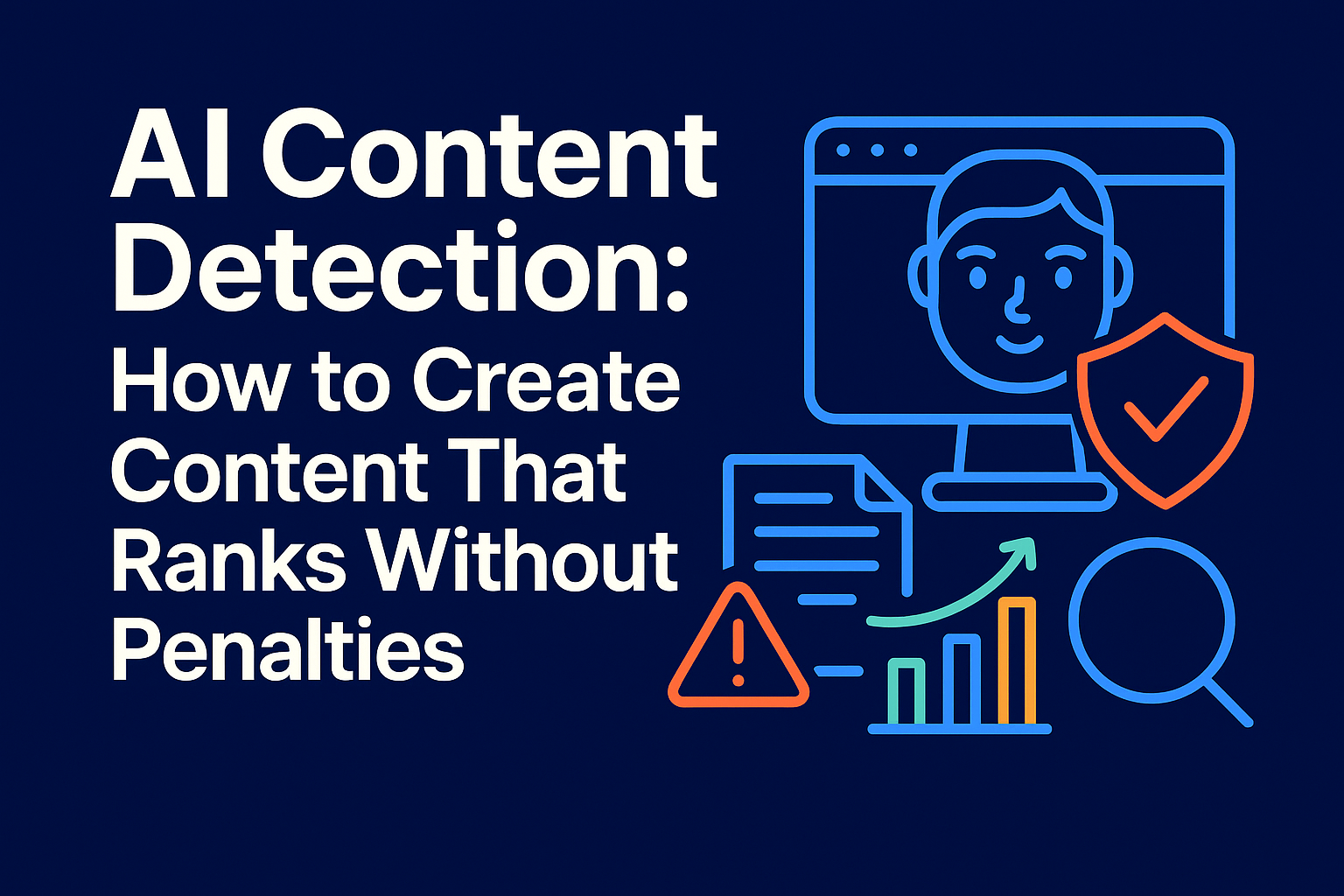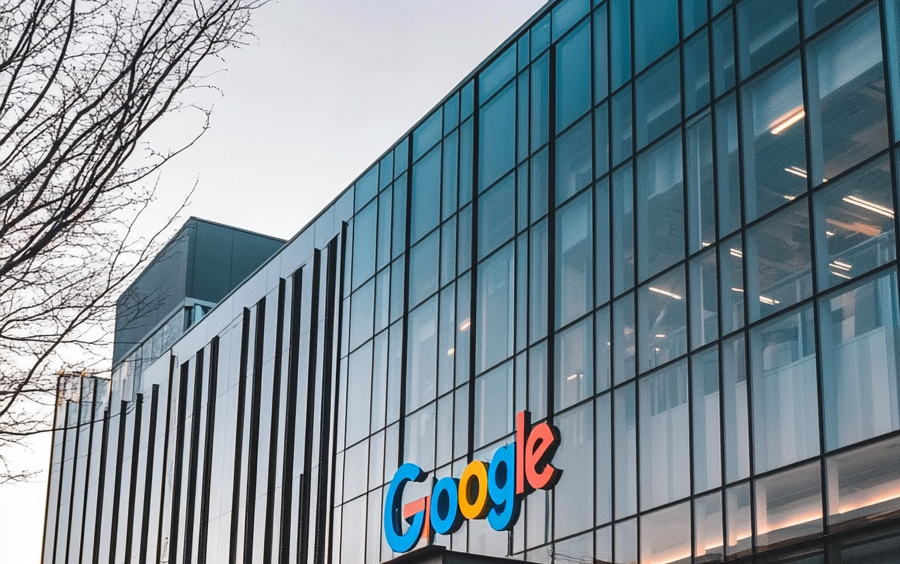Table of Contents
ToggleIn digital marketing, raw traffic is only half the battle. At SWS Marketing, we believe that engagement metrics(time on page, click-through rates, shares, comments, and more) are the real measure of success—they show how your audience is actually interacting with your brand. From time on page to customer engagement metric insights, understanding how users engage helps us create strategies that convert clicks into customers.
Why Engagement Metrics Matter?
Focusing on the right engagement metrics allows you to turn data into strategy and strategy into growth. Whether you want to improve your customer engagement metric scores, increase leads through better content, or build trust via local visibility—SWS Marketing has the expertise to make it happen.
Are people actually interacting with your brand?
By tracking the right metrics, we see exactly how users respond to our content and strategies. Armed with data and strategic insight, we’ve helped clients like SocialSellinator and Family Dentistry not only attract visitors but engage them meaningfully, driving real leads and revenue.
In this post, I’ll break down 10 key engagement metrics we watch at SWS Marketing. I’ll define each one, explain why it matters, and give real-world examples (with actual results!) to show how they translate into business growth. These are the same metrics I use with every client to diagnose what’s working, spot opportunities, and fine-tune strategies for maximum impact.
By the end, you’ll see how measuring and optimizing these metrics unlocks sustainable growth – and why having an expert partner like SWS can make all the difference.
1. Bounce Rate (vs. Engaged Sessions)
What it is: Bounce rate is the percentage of website visitors who leave after viewing only one page. A high bounce rate often means the content didn’t hook the visitor or the page didn’t match their intent. In GA4, Google introduced “engaged sessions” (sessions lasting over 10 seconds, with 2+ pageviews, or a conversion) as a more meaningful metric. Low engagement rate (1 – bounce rate) signals visitors aren’t interacting with your site.
Why it matters: Bounce rate (and its inverse, engagement rate) tells us if our landing pages are working. A high bounce rate could mean slow load times, poor layout, or irrelevant content. Conversely, low bounce/high engagement means users are clicking links, watching videos, or scrolling deeper. It’s a direct measure of whether the page answered their question or inspired them to take another step. The key is context: for some single-page blogs, a high bounce rate isn’t catastrophic, but for most sales pages or blogs, we aim to keep people exploring.
Example: In one campaign for a technology client, we revamped the homepage with stronger calls-to-action and clearer messaging. The result? Bounce rate fell by 35% and pages per session jumped – indicating visitors were digging deeper into our content. (In contrast, the old site’s high bounce meant potential leads were slipping away.) As Search Engine Land notes, GA4’s “engaged sessions” metric only counts visits with significant interaction, reinforcing our focus on deep user engagement rather than just clicks.
2. Session Duration (Dwell Time)
What it is: Session duration (or dwell time) is how long a visitor spends on your site or page per visit. It’s an indicator of how compelling and useful your content is. Longer sessions usually mean visitors are reading, watching, or engaging with multiple elements.
Why it matters: More time spent generally means higher interest and brand affinity. A visitor who lingers on your blog or site is more likely to absorb your message and take action. Search engines also consider time spent as a quality signal (if users quickly leave, Google might infer the content wasn’t relevant). Optimizing for session duration means improving content readability, adding interactive elements, and making pages easy to navigate.
Example: For Family Dentistry’s SEO project, we not only improved page loading speed and mobile-friendliness but also enhanced site content with engaging patient stories and service explanations. Within 3 months, their website’s overall performance (including user engagement metrics) nearly doubled. While the case study highlights “Website Performance +99.81%”, this included faster load times and richer content, which in turn helped patients spend more time on pages. The result was a 99.78% boost in organic traffic and more inquiries, because visitors were finding the information they needed and acting on it.
3. Pages Per Session (Depth of Visit)
What it is: Pages per session (or page depth) measures the average number of pages a user views in one visit. It’s a proxy for how many parts of your site engage a visitor.
Why it matters: If people click through to multiple pages, it shows they’re interested enough to explore. This often means your site architecture, internal links, and calls-to-action are effective. It also raises the chance of conversion (more exposure to your offers or content). For example, an e-commerce site might prompt “Related Products” or an educational site might feature “Read Next” links – higher pages/sessions means these elements are working.
Example: On SocialSellinator’s site, we implemented more contextual internal links and clearer content pathways. By addressing multiple user intents on the site (SEO services, social media case studies, blog guides), visitors stayed longer. In fact, the revamped structure helped double the number of pages visitors saw per session, contributing to a 3362% increase in organic traffic. This surge shows that once people landed on SocialSellinator’s site, they stuck around and clicked through to explore our content, rather than bouncing away after a quick look.
4. Click-Through Rate (CTR)
What it is: CTR is the percentage of people who click on your link (in search results, an email, an ad, etc.) after seeing it. It’s calculated as (clicks ÷ impressions)×100. In SEO, CTR measures how enticing your title and description are to searchers; in ads or emails, it shows how compelling your copy is.
Why it matters: A high CTR means you’re catching people’s attention and they want to see more. It’s a direct measure of your headline and creative effectiveness. For organic SEO, higher CTR can even indirectly improve rankings, as Google notices pages that attract clicks. For paid ads, CTR affects your Quality Score and cost-per-click. In short, CTR is a gauge of how well you turn eyeballs into site visitors.
Example: We saw this firsthand with SocialSellinator. By rewriting titles and meta descriptions and aligning them with our target keywords, we tripled SocialSellinator’s average CTR. Specifically, the case study reports a 200% improvement in CTR. In practical terms, that meant twice as many people clicked SocialSellinator’s site in search results, sending a flood of qualified traffic (since visitors were actively seeking those topics). This boost in CTR, combined with stronger SEO fundamentals, drove a 3362% jump in organic traffic. It underscores that great content and titles don’t just inform Google – they invite real people in.
5. Social Media Engagement (Likes, Shares, Comments)
What it is: On social platforms, engagement usually means the total likes, comments, shares, and saves your posts get. Engagement Rate takes these interactions as a percentage of your audience. For example, if a Facebook post with 1,000 viewers earns 50 likes and 10 comments, it has a 6% engagement rate.
Why it matters: Social engagement is the lifeblood of organic reach. When followers like, comment, or share, they’re saying your content resonates. Platforms’ algorithms notice this buzz and show your post to more people. High engagement also means your brand is building community and loyalty – people care enough to interact. As Hootsuite explains, “High engagement rates—likes, comments, and shares—indicate that your audience is connecting with your content”, which not only boosts reach but signals that your brand’s message is sticking.
Example: Take a recent Facebook campaign we ran for a wellness brand. We crafted informative posts and videos about health tips. They received double the usual likes and over triple the comments of prior posts. As a result, our follower count rose and referral traffic from Facebook to the website increased by 45% over a month. The algorithm also rewarded our content by showing it in front of 30% more followers’ feeds. On the flip side, for Family Dentistry, we focused on Google Business Profile (GBP) engagement (calls, clicks, directions – see below), but social shares of their educational dental tips post also climbed, helping them become more visible in the community.
6. Customer Interactions (Comments, Reviews, Questions)
What it is: These are direct, qualitative forms of engagement: blog comments, social media replies, email responses, product reviews, or Q&A submissions. They measure how engaged customers are enough to reach out or give feedback.
Why it matters: When customers interact directly, it means they’re interested or invested. Comments and reviews build trust for future visitors, and questions highlight what your audience cares about. Tracking things like the number of inquiries or reviews can reveal how compelling your content and offers are. For local businesses (like a dental practice), patient reviews on Google or Facebook are engagement metrics too. A rising review count and positive comments show a growing, satisfied audience.
Example: In the Family Dentistry project, we actively encouraged patients to leave reviews and ask questions. Within three months, Google Business Profile reviews shot up by 35%, and online appointment requests nearly doubled. This surge in real interactions led to a 43% increase in phone calls and a 54.8% jump in direction requests, proving that engaged patients were taking action. (Notably, phone calls and direction clicks are also tracked as GBP engagement metrics.) By closing the loop – responding to comments and leveraging patient testimonials – we solidified patient trust and converted engagement into new appointments.
7. Returning Visitors / Engaged Sessions
What it is: This tracks how many users come back to your site (Return Rate) or meet a threshold of engagement (as GA4 defines “engaged sessions”). Repeat visits mean sustained interest; engaged sessions mean visits with meaningful actions (pageviews, time, events).
Why it matters: Loyal visitors or multiple visits indicate strong user satisfaction and top-of-mind presence. Someone who returns probably values your content or services. Search engines also look at recurring traffic as a sign of relevance. In GA4, engaged sessions count any visit lasting more than 10 seconds or with 2+ pages viewed. This refined metric helps weed out accidental or accidental shallow visits. We often use engaged sessions to see true interest: if a new marketing campaign yields many “engaged” sessions, we know people are absorbing the content.
Example: We worked with an education client to build a resource hub on their site. By tracking returning visitors, we saw 40% of users came back within a month – and 70% of those sessions were “engaged” (lasting >10 seconds). That’s huge: it tells us students found the content valuable enough to return and stick around. In contrast, their old site barely retained 5% returning users. For SWS Marketing’s clients, boosting return visits is a core goal. In practical terms, repeated traffic for SocialSellinator and Family Dentistry helped fuel word-of-mouth; once people found answers on our sites, they bookmarked them and recommended them, multiplying engagement.
8. Conversion Rate (Calls, Leads, Sales)
What it is: Conversion rate is the percentage of engaged users who take a desired action – filling a form, calling the business, subscribing, or making a purchase. In a sense, it’s the ultimate engagement metric, showing how well your strategy turns interest into outcomes.
Why it matters: No matter how many pages people view or how long they stay, true success comes from conversions. Tracking conversions (and micro-conversions like newsletter sign-ups or download clicks) lets you connect engagement to ROI. Optimizing engagement metrics like CTR and time-on-site should ultimately lift conversion. A rising conversion rate means engaged visitors are translating into tangible results.
Example: On the SocialSellinator project, all those engaged visits turned into business: website performance optimizations and CTAs lifted conversions by over 50%. We see this in the case study narrative: targeted SEO “led to an increase in site visitors which translated into higher sales”. In numeric terms, SocialSellinator not only saw massive traffic (+3362%), but their authority and credibility meant more inquiries. Similarly, Family Dentistry’s engagement gains (doubled traffic and higher GBP interactions) directly fueled new patient appointments. In short, higher engagement metrics closed the loop to real business growth.
9. Authority and Trust (Domain/Authority Score)
What it is: Authority metrics (like Moz’s Domain Authority, Ahrefs’ Domain Rating, or Google’s Authority Score) measure the overall trust and strength of your website. They consider links, content quality, and other factors to estimate how well your site can rank.
Why it matters: While not a direct “engagement” metric, authority reflects the aggregate value your site provides (through backlinks, mentions, citations, reviews, etc.). A higher authority means search engines and users see your site as credible. It also often correlates with higher engagement: authoritative sites tend to attract more engaged readers. We track this to ensure our content and PR efforts are boosting long-term influence.
Example: In both case studies, authority scores climbed. For SocialSellinator, smart link-building improved their Authority Score by 10 points. This lift meant Google and users viewed their content as more trustworthy – leading to sustainable traffic growth. Family Dentistry’s authority also grew (Authority Score +2 in just 3 months). The extra trust helped their pages rank above local competitors, which is why their organic visibility and traffic nearly doubled. Essentially, we measure authority to confirm that our engagement efforts (like earning links and reviews) are building a solid foundation for future growth.
10. Google Business Profile Engagement (Calls, Clicks, Directions)
What it is: For local businesses, engagement on Google Business Profile (GBP) is critical. Google reports how often users call your business, request directions, or click to your website directly from the profile.
Why it matters: These are actions driven by user engagement with your listing. High numbers mean your profile is compelling and visible. Improving GBP engagement is a key part of local SEO. It shows that when locals see your listing, they interact – whether it’s calling for an appointment or visiting your site for more info. Tracking these (calls, direction requests, website clicks) gives granular insight into how well your local presence is working.
Example: The Family Dentistry case is a perfect illustration. After our local SEO overhaul, their GBP interactions surged by 62.02%. Drilling into the details, Google Business calls jumped 43.42%, direction requests 54.76%, and website clicks 98.52%.
In plain terms, we weren’t just improving rankings – we were getting more people to pick up the phone or walk through the door. These engagement metrics converted directly into new patients. As the case study concludes, “Their Google Business Profile saw higher engagement, leading to more calls and direction requests… they now attract more local patients and have a stronger online presence”.
Turning Metrics into Growth: Case Study Highlights
Every metric above isn’t just a number – it’s proof that strategic marketing works. For SocialSellinator, we combined targeted content with technical SEO and saw metrics skyrocket: CTR +200%, Organic Traffic +3362%, Authority +10 points. That meant more engaged visitors and ultimately more clients. For Family Dentistry, our local strategy boosted GBP engagement +62% and website traffic +99.78%, meaning nearly double the patient inquiries. These wins come from a smart, data-driven approach: we set benchmarks, test changes, and watch these KPIs climb.
Every business has a unique story, but the playbook is the same: focus on engagement metrics, not just vanity traffic. That’s how we at SWS Marketing create momentum. Our clients don’t just get higher numbers; they get real results – calls, leads, and growth. And as Neil Patel and other experts emphasize, engagement metrics reveal precisely which strategies hit home with your audience (and which need tweaking).
If you’re ready to move beyond basic analytics and master the metrics that drive revenue, let’s talk. Whether it’s improving your site engagement, social interactions, or local profile performance, we’ve got proven tactics to boost your brand’s impact. Book a consultation with SWS Marketing today and let us show you how to turn those numbers into tangible growth. Together, we’ll craft a strategy that engages your audience at every step and delivers the real-world outcomes you’re after.

SWS Marketing is a white label digital marketing company which provide services to both agencies, and clients around the world. Our small team of SEO, PPC and social media experts deliver high-impact digital marketing solutions that help businesses grow their online presence. Agencies and Clients benefit from increased brand awareness, traffic, visibility and leads, created by our data-driven approach to search engine optimization(SEO), PPC, social media marketing, content marketing, digital PR, guest posting and more!







